WBBSE Class 8 History Chapter 8 Topic C Miscellaneous Topic C Miscellaneous Strike The Odd One Out
Question 1. Aligarh Movement, Farazi Movement, Wahabi Movement, Santhal Kherwa Movement.
Answer: Aligarh Movement
Question 2. Syed Ahmed Khan, Sidhu, Titu Mir, Dudu Mian.
Answer: Syed Ahmed Khan
Question 3. Muslim League, Anushilan Samity, Jugantar Dal, Indian Association
Answer: Muslim League
Question 4. Treaty of Munich, Treaty of Locarno, Treaty of Versailles, Poona Pact.
Answer: Poona Pact
Question 5. Aga Khan, Shaukat Ali, Badruddin Tyabji, Muhammad Ali
Answer: Badruddin Tyabji
Question 6. Discovery of India, Now or Never, The Indian Struggle, India Wins Freedom.
Answer: Now or never
Read and Learn More WBBSE Solutions For Class 8 History
Question 7. Rabindranath Tagore, Nazrul Islam, Jivananda Das, Muhammad Iqbal.
Answer: Muhammad Iqbal
Question 8. Chaudhuri Rahmat Ali, Fazlul Huq, Maulana Abul Kalam Azad, Sikander Hayat
Answer: Maulana Abul Kalam Azad
Question 9. Radcliff Line, Macmohan Line, Durand Line, Line of Control.
Answer: Radcliff Line
WBBSE Class 8 Miscellaneous Notes on Communalism
Question 10. Gandhiji, Netaji, Madan Mohan Malviya, Jawaharlal Nehru.
Answer: Madan Mohan Malviya
Question 11. Noakhali, Mysore, Hyderabad, Kashmir.
Answer: Noakhali
Question 12. Khilafat Movement, Non-cooperation Movement, Civil Disobedience Movement, Quit India Movement.
Answer: Khilafat Movement
WBBSE History Chapter 8 Miscellaneous key Points And Answers Topic C Miscellaneous Match The Columns
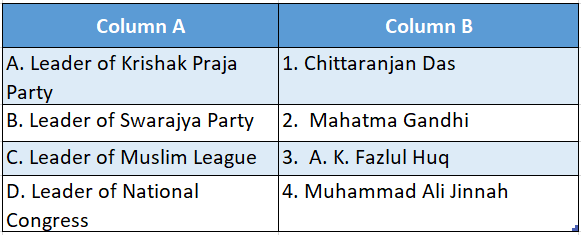
Answer: A-3,B-1,C-4,D-2
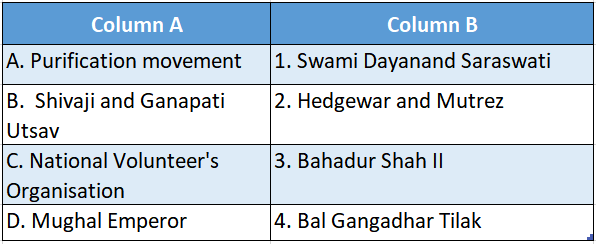
Answer: A-1,B-4,C-2,D-3
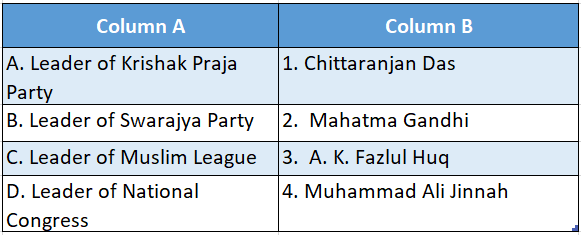
Answer: A-2,B-4,C-1,D-3
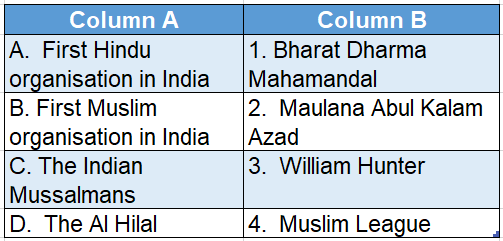
Answer: A-1,B-4,C-3,D-2
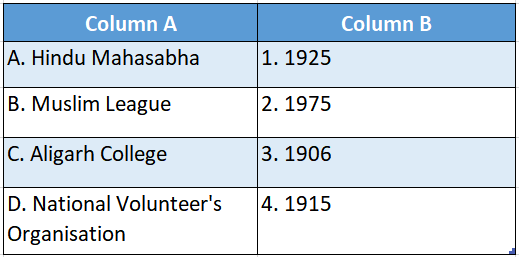
Answer: A-4,B-3,C-2,D-1
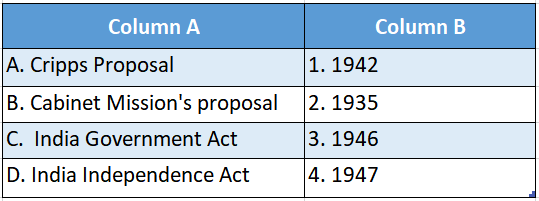
Answer: A-2,B-4,C-1,D-3
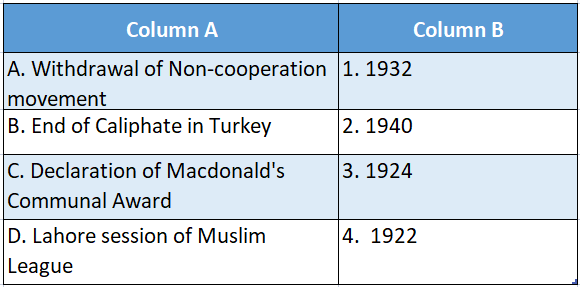
Answer: A-4,B-3,C-1,D-2
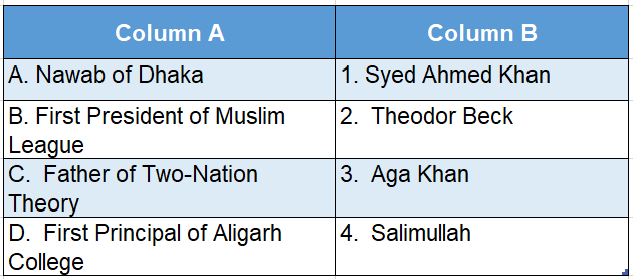
Answer: A-4,B-3,C-2,D-4
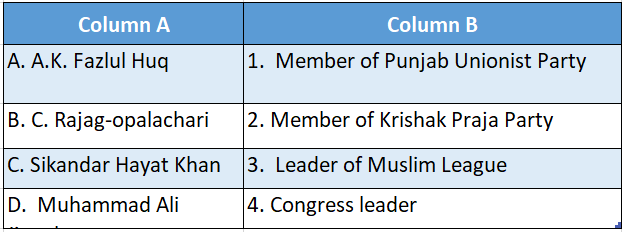
Answer: A-4,B-3,C-1,D-2
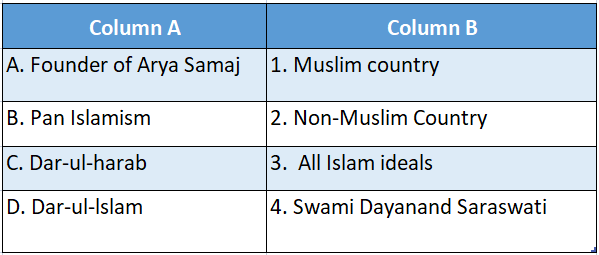
Answer: A-4,B-3,C-2,D-1
Chapter 8 From Communalism To The Partition Topic C Miscellaneous Fill In The Blanks With The Correct Alternative
Question 1. English became the official language in colonial India, replacing Persian in ________________ (1847/1837/1850).|
Answer: 1837
Question 2. The modernization attempt of Indian Muslim Society was started by ________________ (Muhammad Ali Jinnah/Sir Syed Ahmed Khan/Moulana Abul Kalam Azad).
Answer: Sir Syed Ahmed Khan
Class 8 History Solution WBBSE
Question 3. The leader of the Peasant People’s Party was ________________ (A.K. Fazlul Huq/Muhammad Ali Jinnah/Jawaharlal Nehru).
Answer: A.K. Fazlul Huq
Question 4. The sovereign state of Pakistan was born on ________________ (15th August 1947/ 14th August 1947/26th January 1947).
Answer: 14th August 1947
Chapter 8 From Communalism To The Partition Topic C Miscellaneous Identify The Wrong Statement
Question 1. Compared to the Muslims, the Hindus were back in the nineteenth century about education, jobs, etc.
Answer: Wrong
Question 2. The Hindu revivalist movement influenced Hindu-Muslim relations.
Answer: Right
Question 3. Mahatma Gandhi did not support Khilafat. Movement.
Answer: Wrong
Question 4. The Pakistan proposal came up in the Lahore session (1940).
Answer: Right
Miscellaneous Events And Impacts Of Partition WBBSE History Chapter 8
Question 1 What was the objective of the Aligarh Movement?
Answer:
Objectives Of The Aligarh Movement:-
The Aligarh Movement began for the overall development of the Muslims.
1. Modernisation of Muslim society:
Through the Aligarh Movement, an attempt was made to modernize the Muslim society.
2. Spread of education among the Muslims:
In colonial India, a need was felt to educate the Muslims and provide them with Western education to bring them to par with the Hindus.
So the Aligarh Movement was launched to spread education among them.
Understanding the Aligarh Movement
3. Building up a scientific attitude:
The Aligarh Movement tried to inculcate scientific thoughts in the minds of the Muslims in order to help them develop a scientific attitude.
Therefore, the Scientific Society was established to fulfill this objective of changing the mindset.
Question 2. To what extent was the Hindu-Muslim relationship influenced by the Swadeshi movement?
Answer:
The Hindu-Muslim Relationship Influenced By The Swadeshi Movement:-
1. Condemnation of partition:
Many members of Muslim society condemned the decision of Lord Curzon to partition Bengal.
The Central Mohammedan Association passed a censure motion against the partition.
2. Meetings and associations:
The Muslims protested against the partition at a public meeting in Kolkata under the leadership of Barrister Abdul Rasul.
3. Prayers:
Namaz was read in Barishal, Mymensingh, and Sreerampore opposing the partition.
4. Leadership:
The anti-partition movement was led by Khwaja Atikulla of Dhaka Abdul Shavan Chaudhuri of Bagura and Maulvi Ismail Siraji of Sirajganj.
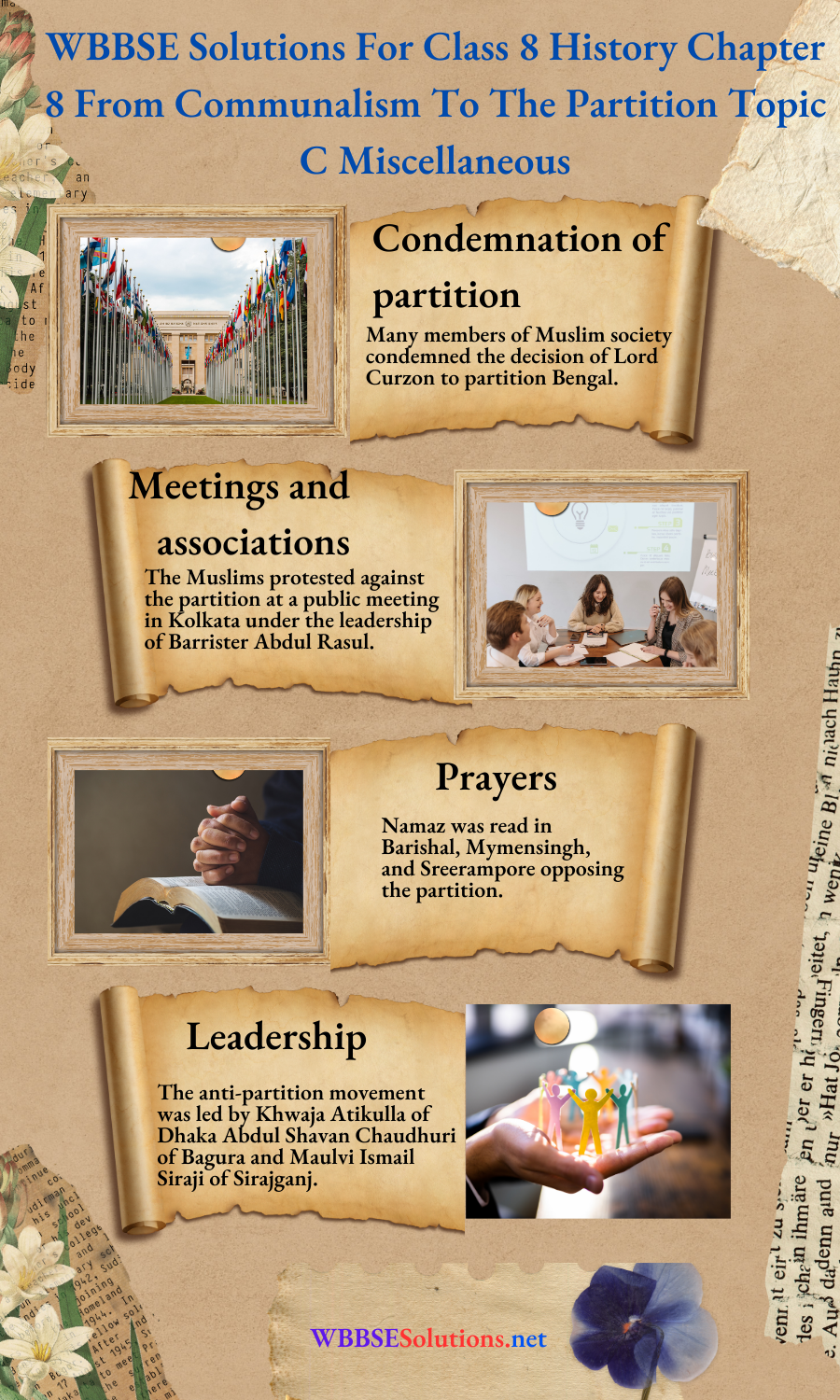
Impact of Education on Muslim Society
Question 3 Why did the Indian Muslims start the Khila Fat Movement?
Answer:
Indian Muslims Started By The Khila Fat Movement:-
1. Dissection of Turkey:
During the First World War Turkey supported Germany and opposed England. When Germany was defeated, the Allies dissected Turkey and abolished the Caliphate.
So the Indian Muslims were offended.
2. British Imperialism:
After the end of the First World War, the British Government dissected Turkey.
So the Indian Muslims launched the Khilafat Movement under the leadership of Shaukat Ali and Muhammad Ali to fight for the prestige of the Caliph.
Question 4. Why is the year 1930 important concerning Hindu-Muslim relations?
Answer:
The Year 1930 Important Concerning Hindu-Muslim Relations:-
The National Congress launched the Civil Disobedience Movement in 1930 under the leadership of Gandhiji.
However, the Muslim League did not participate in it. In the same year, Muhammad Iqbal the President of the Muslim League demanded a separate territory for the Muslims.
Later on Chaudhuri Rahmat Ali, a student of Cambridge University, also put forward a proposal for forming a separate Muslim land including Punjab, North-West Frontier Province, Baluchistan, and Kashmir.
Key Figures in the Aligarh Movement
As a result of this proposal, Ramsay Macdonald, the British Prime Minister introduced the Communal Division Policy known as the Communal Award.
Comprehensive Guide For Miscellaneous Aspects Of Partition WBBSE History
1. Discuss Sir Syed Ahmed Khan’s achievements in taking Muslim society to the path of modernization.
Answer:
Achievements Of Sir Syed Ahmed Khan In Taking Muslim Society To The Path Of Modernization:-
Introduction:
From the very beginning of British rule, the Muslims remained more backward in society in comparison to the Hindus.
Sir Syed Ahmed realized that they would remain so until they became logical and possessed liberal thinking under the influence of Western education.
So he dedicated himself to the task of the overall progress of the Muslims.
Role Of Syed Ahmed Khan
1. Education plan:
- Sri Syed Ahmed tried to modernize Muslim society by spreading Western education among them.
- He founded an English medium school in Gazipur in 1864 to spread English education.
- He also established the Scientific Society in 1865 to create scientific awareness among Muslims.
- He established the committee for the advancement of learning among the Mohammedans of India for the overall development of the Muslims.
- In order to spread higher education among the Muslims he founded the Mohammedan. Anglo-Oriental College (present Aligarh University) in 1875.
2. Attempt at social reformation:
Sir Syed Ahmed took up the task of making Muslim society modern and rational by removing religious bigotry and superstitions.
He vehemently opposed conservatism as well as divorce, child marriage, and polygamy.
3. Attempt at religious reformation:
Sri Syed Ahmed told the Muslims to interpret the Quran from scientific and rationalistic points of view.
He tried to harmonize Islamic principles with modern scientific thinking. He condemned bigots and narrow-mindedness.
He tried to use religion as an instrument for the overall development of Muslim society.
Short Notes on Communal Harmony Efforts
4. Other reforms:
Syed Ahmed also tried to bring about reforms in other aspects of society
- He advised the Muslims to become modern. by giving up medieval thoughts and behavior.
- He condemned the purdah system.
- He also talked about the necessity of women’s education.
5. Opposition of the Congress:
Syed Ahmed began to oppose Congress under the influence of Theodor Beck, the Principal of Aligarh Mohammedan Anglo-Oriental College.
He thought that the National Congress was harmful not only to the Muslims but also to the country.
In order to oppose the Congress directly he established the Educational Congress, United Indian Patriotic Association, and Mohammedan Anglo-Oriental Defence Association.
Question 2. How was the Hindu revivalist movement born in the nineteenth century? What was the effect of such movements in creating a communal mentality?
Answer:
Hindu Revivalist Movement Born In The Nineteenth Century And The Effect Of Such Movements In Creating A Communal Mentality:-
Introduction:
Towards the end of the 19th century, Hindu communalism developed as an opposition to Muslim communalism.
Just as the Muslim League was formed to safeguard the interest of the Muslims, the Hindu Mahasabha also grew up to protect the interests of the Hindus.
Background Of Foundation Of Hindu Mahasabha
1. Movement against cow slaughter:
During the time of the Great Revolt, the Mughal emperor Bahadur Shah II banned the slaughter of cows for the sake of Hindu-Muslim unity.
Later on, the British did not adopt any clear policy against this and so the grievance remained in the minds of the Hindus which inflamed their interest in establishing the Hindu Mahasabha.
Practice Questions on Communalism and Partition
2. Hindi Urdu dispute:
The Hindus favored Hindi while the Muslims favored Urdu. This language rivalry further embittered the relationship between the two communities.
The British government introduced Urdu instead of Persian in Ayodhya and Northwest provinces.
As a reaction to this, a movement arose for the introduction of Hindi in the North-west province, Madhya. Pradesh and Bihar.
This movement helped in the formation of the Hindu Mahasabha.
3. Purification Movement of Arya Samaj:
The Purification Movement of the Arya Samaj began as a reaction against the conversion of Malabar Hindus and the Tanzim and Tabligh introduced in Muslim society.
Several Malkana Rajputs, Gurjars, and Baniyas who had been converted to Islam returned to the fold of Hinduism through the Purification Movement.
This incident encouraged the formation of Hindu Mahasabha.
4. Instigation by the British government:
Communal instigation by the British was also greatly responsible for the rise of Hindu communalism.
The ground of Muslim communalism created by the British government led to the birth of Hindu communalism.
5. Responsibility of the Muslim League:
The Muslim League was dedicated to the overall growth of the Muslims and protecting the interests of their own community.
This worried the Hindus and led to the rise of Hindu communalism which culminated in the formation of Hindu Mahasabha.
Role In Creating Communal Feelings
The Hindu Revival Movement played an important role in creating a communal attitude. It aimed at protecting the interests of the Hindus.
Naturally, the communal atmosphere that grew up under the leadership of the Muslim League was further fuelled by the Hindu Revival Movement.
The slogan of the movement was ‘Hind Hindi Hinduism’.
Important Definitions Related to Communalism
Question 3. How were the Muslim leaders alienated from Congress after the non-violent non-cooperation movement?
Answer:
The Muslim Leaders Alienated From Congress After The Non-Violent Non-Cooperation Movement:-
Introduction:
After the Cooperation movement, many Muslim leaders deserted the Congress.
The selfish motives of the Muslim leaders as well as the indifference of the Congress leaders were responsible for this.
Distance Between Muslim Leaders And Congress
1. Responsibility of Muslim leaders:
Helping separatism: After the Noncooperation Movement some Muslim leaders tried to spread separatist ideas.
So the atmosphere of communal harmony was lost and a distance from the Congress was created.
2. Communal self-interest:
The Orthodox Muslims entered national politics through the Khilafat Movement. They preached narrow communal selfish thoughts.
In the agenda of Jamiyat al Ulema I Hind, emphasis was placed on the protection of Muslim interests. So a distance was created with the Congress.
3. Spread of communalism:
In the later phase of the Khilafat Movement, both Hindu and Muslim communalism spread. Tabligh (preaching) and Tanzin (organization) gained momentum in 1923.
The anti-Hindu uprising in Kohat helped in the spread of Muslim communalism.
4. Negligence of the Congress towards the League:
The Khilafat leader Hasrat Mahani proposed that the Congress and the League ought to plunge into the cause of attaining Swaraj jointly.
If the British government passed Emergency Acts then they should combat it together. However,
Gandhiji and other leaders did not respond to it and so, many Muslim leaders deserted the Congress.
History Class 8 WBBSE
2. Responsibility of National Congress:
1. Combining Noncooperation and Khilafat Movements:
The decision to combine Khilafat and Non-cooperation movements was a blunder on the part of Gandhiji as well as the Congress.
This is because the Khilafat Movement stopped when Kamaal Pasha came to power in Turkey and abolished the post of Caliph.
So the Muslims who had joined the Non-cooperation Movement through the Khilafat Movement detached themselves.
2. Question of leadership:
The Non-Co-operation Movement was solely led by Congress.
Muslim leaders like Maulana Shaukat Ali, Maulana Muhammad Ali, and Maulana Hasrat Mohani were not given the same importance as Gandhiji or Jawaharlal Nehru.
Before that when the Ali brothers were arrested in 1921 the Congress leaders showed no response and this hurt the sentiments of the Muslims.
3. Vagueness of the Swaraj ideal:
Before the Noncooperation Movement Gandhiji had promised to attain Swaraj in a year but this did not happen.
Again, many Muslims were not inspired by Gandhiji’s Charka Satyagraha.
Gandhiji’s idea of the so-called perfect kingdom seemed meaningless to the Muslims.
4. Indifference of the Congress:
The National Congress did not give much priority to the protection of Muslim interests after the Non-cooperation Movement.
Apart from the solution to the Khilafat problem, no other issue concerning Muslim interest found a place in the non-cooperation agenda.
So most of the Muslim leaders became disgusted.
Question 4. How did the partition of India become imminent between 1940-1947? Do you think the partition of India was unavoidable? Give reasons for your answer.
Answer:
Partition Of India Become Imminent Between 1940-1947:-
Introduction:
Different incidents that took place between 1940 and 1947 created the background for the partition of India.
Background Of Partition Of India
1. Lahore session of Muslim League:
At the Lahore session of the Muslim League (1942), Jinnah declared that the Hindus and Muslims were two separate communities.
Fazlul Huq, the Prime Minister of Bengal, made a proposal of creating a new state by combining the Muslim-inhabited areas of north-western and eastern India.
History Class 8 WBBSE
2. Rajaji Sutra or C. R. Formula:
Chakravorty Rajagopalachari initiated a formula in 1944 to prevent the splitting of India according to Jinnah’s proposal. This is called Rajaji Sutra or C. R. Formula.
3. Wavell Plan:
Viceroy Wavell summoned a meeting with the Indian leaders at Simla on June 25, 1945, to remove the political stagnation in India.
Maulana Azad and Jinnah attended the meeting on behalf of the Congress and Muslim League respectively.
Jinnah demanded that all Muslim representatives in the Parliament should be from the Muslim League but the Congress did not agree to this.
4. Failure of Cabinet Mission:
The Cabinet Mission proposed to divide the country on a communal basis in order to grant freedom to India and frame the future constitution.
The failure of the Cabinet Mission paved the way for partition.
5. Mountbatten Plan:
The British government now regarded the partition of the country to be inevitable in order to stop the communal riots.
Mountbatten’s advisor sent the partition plan to the British Parliament on July 18, 1947.
Partition of the country became assured as the final outcome of Mountbatten’s Plan.
6. Partition of India:
The British government declared the determined agenda of granting independence to India.
The League remained adamant in its demand for a separate state. Mountbatten explained to the Congress leaders
that it was impossible to re-establish peace without partition. The Congress finally agreed under the pressure of circumstances.
Whether Partition Was Inevitable
The undivided Indian State was divided into two separate states-India and Pakistan. There is a controversy regarding the inevitability of the partition.
Some people think that there was no alternative to it. Others think that it could have been avoided.
Probably, the contemporary political situation had made such a heart-rending decision like the partition of India inevitable.
Even Congress leaders like Nehru and Patel were compelled to accept Jinnah’s demand of forming a separate Pakistan.
Conceptual Questions on Social Dynamics Before Partition
Imagine and write
Question5. Suppose you learned of the partition of India on 14th August 1947. Now you have to leave your home and go elsewhere. Write in your own words what would be your reaction in such a situation.
Answer:
My Reaction Towards The Partition Of India On 14th August 1947:-
The most heart-rending event in Indian history was the partition of India. I came to know about it on August 14, 1947.
I learned that the border of the two countries was decided on the basis of the map drawn by the British lawyer Cyril Radcliffe.
Bengal and Punjab were dissected according to this map. Pakistan was made up of East Bengal and West Punjab. West Bengal and East Punjab remained in India.
Before the joy of independence faded, I felt the pangs of partition like other Indians.
This agony has been expressed in books like Buddhadev Basu’s ‘Ekti Jiban’, Bhisma Sahani’s ‘Tamas, Tarashankar Banerjee’s ‘Bipasha’, and Sushanta.
Singh’s ‘A Train to Pakistan’, Prafulla Roy’s ‘Keya Patar Nauka, and in films like Rittik Ghatak’s ‘Meghe Dhaka Tara’, ‘Subarnarekha’, ‘Komal Gandhar’ and Nimai Ghosh’s ‘Chinnamool’.
A great disaster came upon us as a result of this heinous decision of partition.
Examples of Cultural Movements During Colonial Rule
Fratricidal riots, plunder, molestation of women, and forcible conversion started everywhere. We became utterly helpless.
We lost our homes and other properties and became rootless refugees. Many Muslim refugees of East Punjab went to West Punjab.
Similarly, many Hindus and Sikhs were forced to come from West to East Punjab.
No value was given to the opinion of millions of refugees whether they desired the partition or not.
Indian and Pakistani governments decided to exchange population. Both gave assurances of security and rehabilitation of the refugees.
However, the assurances turned out to be in vain. The future of millions of rootless persons was plunged into the pit of darkness.
